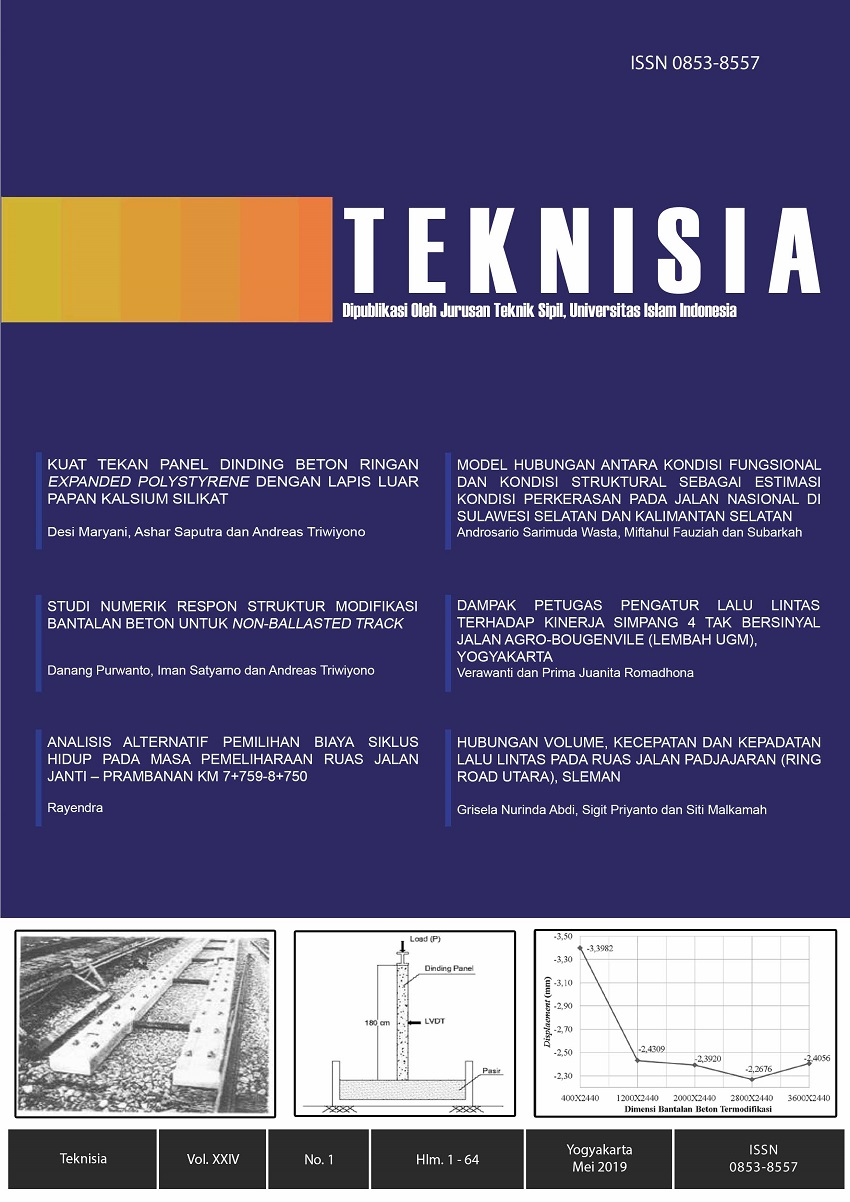Main Article Content
Abstract
A macroscopic movement of traffic consists of traffic volume, speed and density which are used to evaluate the quality of transportation system. By analysing these three variables, a result which infrom about the condition about a transportation system will be provided. The information from the analysis of the variables shows the condition of the traffic condition through the traffic volume and density. When a road has a bad condition of transportation system, the analysis will describe it through high density of traffic and the maximum traffic volume is exceeded.
This research is conducted on Padjajaran Street to evaluate the characteristic of transporatation system on the road.The data, which were collected, consists of traffic volume and spot-speed on every lane of the road. Those were collected on Monday, Wednesday, Saturday and Sunday at peak-hours, which are 6.30am-8.30am, 11am-1pm and 4pm-6pm. The analysis used vehicles classification according to MKJI 1997 and conducted an analysis through several models, which are Greenshield, Greenberg, Underwood and Bell models. By comparing these four models, the best one is chosen and become the model to describe the quality of the transportation system on Padjajaran Street.
The best result according to the value of R2 and the analysis of the traffic variables, every lane has their own best model which can be applied. However, most of the lanes are well-modelled using Underwood method. Finally, it comes to a conclusion that Padjajaran Street is classified as urban road.Keywords
Article Details
Under the following term:
-
Attribution — You must give appropriate credit, provide a link to the license, and indicate if changes were made. You may do so in any reasonable manner, but not in any way that suggests the licensor endorses you or your use.
-
ShareAlike — If you remix, transform, or build upon the material, you must distribute your contributions under the same license as the original.
- No additional restrictions — You may not apply legal terms or technological measures that legally restrict others from doing anything the license permits.
References
- Direktorat Jenderal Bina Marga, Departemen Pekerjaan Umum RI, 1997. “Manual Kapasitas Jalan Indonesia”, Jakarta.
- Khisty, C.J & Lall, B. K, 2005, “Dasar-Dasar Rekayasa Transportasi Edisi Ketiga Jilid I”, Jakarta, Erlangga.
- Kurniawan, Yusrizal, 2009, Modeling Speed -Density, Flow - Speed, and Flow - Density Relationships at Jakarta Freeway a Case Study at Wiyoto Wijono Corridors, Tesis, Yogyakarta : MSTT UGM.
- May, Adolf D., 1990, “Traffic Flow Fundamentals”, University of California, Berkeley.
- Munawar, A. , 2011, “Dasar – Dasar Teknik Transportasi”, Beta Offset, Yogyakarta.
- Sjamsinarsih, Rani, 1998, “Hubungan Antara Kecepatan Aliran Dan Kepadatan Lalu lintas (Studi Kasus Jalan Yogyakarta Tempel & Jalan Yogyakarta – Prambanan)”, Tesis, Yogyakarta : MSTT UGM.
- Sumanjaya, 1998, “Pengaruh Kendaraan Parkir di Badan Jalan Terhadap Hubungan antara Kecepatan, Aliran dan Kepadatan Lalu lintas”, Tesis, Yogyakarta : MSTT UGM.
- Tamin, O. Z, 1992, “Hubungan Volume, Kecepatan dan Kepadatan Lalu lintas di Ruas Jalan H.R. Rasuna Said (Jakarta)”, Jurnal Teknik Sipil, Jurusan Teknik Sipil iTB, No 5, Hal 1-11, ISSN: 0853-2982.
- Tamin, O. Z. , 2008, “Perencanaan, Pemodelan, & Rekayasa Transportasi”, ITB, Bandung.
References
Direktorat Jenderal Bina Marga, Departemen Pekerjaan Umum RI, 1997. “Manual Kapasitas Jalan Indonesia”, Jakarta.
Khisty, C.J & Lall, B. K, 2005, “Dasar-Dasar Rekayasa Transportasi Edisi Ketiga Jilid I”, Jakarta, Erlangga.
Kurniawan, Yusrizal, 2009, Modeling Speed -Density, Flow - Speed, and Flow - Density Relationships at Jakarta Freeway a Case Study at Wiyoto Wijono Corridors, Tesis, Yogyakarta : MSTT UGM.
May, Adolf D., 1990, “Traffic Flow Fundamentals”, University of California, Berkeley.
Munawar, A. , 2011, “Dasar – Dasar Teknik Transportasi”, Beta Offset, Yogyakarta.
Sjamsinarsih, Rani, 1998, “Hubungan Antara Kecepatan Aliran Dan Kepadatan Lalu lintas (Studi Kasus Jalan Yogyakarta Tempel & Jalan Yogyakarta – Prambanan)”, Tesis, Yogyakarta : MSTT UGM.
Sumanjaya, 1998, “Pengaruh Kendaraan Parkir di Badan Jalan Terhadap Hubungan antara Kecepatan, Aliran dan Kepadatan Lalu lintas”, Tesis, Yogyakarta : MSTT UGM.
Tamin, O. Z, 1992, “Hubungan Volume, Kecepatan dan Kepadatan Lalu lintas di Ruas Jalan H.R. Rasuna Said (Jakarta)”, Jurnal Teknik Sipil, Jurusan Teknik Sipil iTB, No 5, Hal 1-11, ISSN: 0853-2982.
Tamin, O. Z. , 2008, “Perencanaan, Pemodelan, & Rekayasa Transportasi”, ITB, Bandung.
